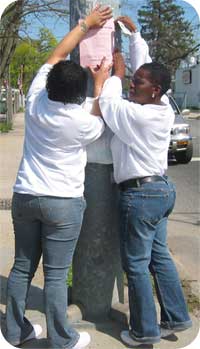 |
 |

By Beryl Lieff Benderly
On a suburban street known as a hangout for drug abusers, a nondescript camper van pulls to the curb and stops.
A knot of people idles on the sidewalk, perhaps waiting for something to |
happen. They eye the vehicle and a few of them begin moving casually toward it. Soon they are talking with the people inside. Before long, one of them has stepped into the van.
It is a scene that an uninformed onlooker might think would arouse the suspicion of the local police. Instead, it has their hearty approval. Four days a week, this unmarked vehicle plies the streets of Nassau and Suffolk counties on Long Island, NY, on the lookout for substance abusers. It gives them something that can save rather than destroy their lives: free HIV testing and a range of other services including referrals to drug treatment, health care, housing, and more.
Riding in the vehicle are two trained health educators on the staff of Project Safety Net, a program of the Long Island Association for AIDS Care (LIAAC), a 75-person agency that is one of the oldest and largest providers of HIV services in the region.
LIAAC is a SAMHSA grantee under the Targeted Capacity Expansion Grants for Substance Abuse Services and HIV/AIDS Services (TCE/HIV) and the Rapid HIV Testing Initiative (RHTI) programs. (See Two SAMHSA HIV/AIDS Programs.)
“Rapid testing is one of SAMHSA’s true legacies,” said Beverly Watts Davis, SAMHSA’s HIV/AIDS Matrix Lead. “It’s one of the important initiatives that’s changing the way we do business. Rapid testing changes people’s knowledge of their health status so they can improve what they do about it.
There are also other important rapid testing initiatives underway at SAMHSA, including successful faith-based initiatives and programs at minority education institutions reaching underserved populations in very innovative ways. I am looking forward to sharing these programs with our constituents in the future.”
Services to the People
The SAMHSA TCE/HIV and RHTI grant programs “really changed the way we delivered services,” said LIAAC Executive Vice President for Operations, Jeffrey Friedman, M.A. In an area with sparse public transportation and a high cost of living that keeps many low-income Long Islanders from owning cars, LIAAC formerly worked from fixed locations and waited for clients to come to them. But then a SAMHSA TCE/HIV grant awarded in 2001 permitted the organization to buy a van, furnish it as a mobile office, and train outreach counselors.
 |
 |
Outreach staff members post a flyer announcing the HIV outreach van's daily locations in Long Island, NY. |
|
Four days a week the vehicle goes to “the street, shelters, bus depots, and train stations, to really meet people where they are and bring services to them,” Mr. Friedman said. The counselors spend the fifth day in the office, completing the paperwork that carefully documents their activities.
Those they serve under this SAMHSA grant are mainly at-risk African Americans and Hispanics, with a history of substance use, who live in Nassau and Suffolk counties.
In its early days, LIAAC’s outreach program, Project Safety Net, offered a 48-hour HIV test that required a second meeting to inform the client of the result. Then, in 2004, SAMHSA made rapid testing for HIV available under RHTI, introducing a new 20-minute HIV test, along with training in its use.
LIAAC was “one of the first to sign up,” said
David Thompson, SAMHSA’s HIV Team Leader.
The new version “works much better,” according
to Juanita Cabral, a Project Safety Net counselor
who administers the tests. Clients avoid several
days of anxiety, and counselors no longer need
to meet a second time to give the test results.
Building Trust
Every year, nearly 2,000 high-risk people connect with Project Safety Net, and more than 300 learn their HIV status through rapid HIV testing. This level of acceptance results from a great deal of work. At first, counselors first went to the streets dressed in caps, shirts, or jackets bearing the Project Safety Net logo. But LIAAC soon discovered that it had substantially underestimated the difficulty of reaching and winning the confidence of high-risk individuals.
In the stigmatized world of HIV/AIDS, LIAAC decided early on that Project Safety Net logos and identifiable markings would be removed from the van. However, Project Safety Net’s official outfits have discreet logos that clients can recognize. This helps to brand the program in the community.
LIAAC also underestimated the effort to recruit and retain staff members who could succeed at a task that has a high emotional content, especially when clients must receive bad news about their HIV status. For counselors, frustrations also increased when individuals did not engage with the important services offered.
LIAAC initially assumed that simply parking the mobile office in places where high-risk people hung out would put program staff in touch with the target population. They soon learned, however, that not everyone at these locations was a high-risk person and that connecting with the right individuals required patiently building social networks.
To build trust, staffers learned to meet substance abusers through introductions from other substance abusers and to build relationships with local “gatekeepers,” such as owners of nearby retail businesses, who could know the local people and could provide connections.
Even after counselors make contact with at-risk individuals, persuading them to agree to testing and services takes an average of 3 to 4 encounters—and sometimes as many as 10—with each individual.
|
Editor's Note: All photos in Part 1 and 2 of this article courtesy of Long Island Association for AIDS Care.
|
See Also—Expanding HIV Assistance
See Also—Article: Part 2 »
Two SAMHSA HIV/AIDS Programs Reach Those in Need »
Resources on HIV/AIDS »
HIV/AIDS Consumer Guide »
Next Article »
Back to Top
|